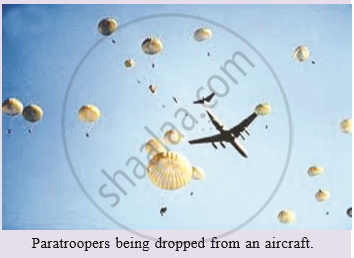Advertisements
Advertisements
प्रश्न
A gun of mass 3 kg fires a bullet of mass 30 g. The bullet takes 0.003 s to move through the barrel of the gun and acquires a velocity of 100 m/s. Calculate:
- the velocity with which the gin recoils.
- the force exerted on gunman due to recoil of the gun
उत्तर
Given Data:
- Mass of the gun (M) = 3 kg
- Mass of the bullet (m) = 30 g = 0.03 kg
- Velocity of the bullet (v) = 100 m/s
- Time taken by the bullet to move through the barrel (t) = 0.003 s
1. Velocity with which the gun recoils:
From the law of conservation of momentum:
Total initial momentum = Total final momentum
Initially, both the gun and bullet are at rest, so total momentum is zero. After firing:
M⋅V + m⋅v = 0
Where V is the recoil velocity of the gun. Rearrange the equation to find V:
`V = -(m.v)/M`
`V = - (0.03 xx 100)/3`
−1 m/s
2. Force exerted on the gunman due to recoil:
The force exerted on the gunman can be calculated using Newton's Second Law:
F = M × a
`a = (ΔV)/t`
Here, ΔV = 1 m/s and t = 0.003 s
`a = 1/0.003` = 333.33 m/s2
F = 3 × 333.33 = 1000 N
Final Answers:
- Recoil velocity of the gun = 1 m/s
- Force exerted on the gunman = 1000 N
APPEARS IN
संबंधित प्रश्न
Two objects of masses 100 g and 200 g are moving along the same line and direction with velocities of 2 m s−1 and 1 m s−1, respectively. They collide and after the collision, the first object moves at a velocity of 1.67 m s−1. Determine the velocity of the second object.
Two objects, each of mass 1.5 kg are moving in the same straight line but in opposite directions. The velocity of each object is 2.5 m s−1 before the collision during which they stick together. What will be the velocity of the combined object after collision?
A stream of water flowing horizontally with a speed of 15 m s–1 gushes out of a tube of cross-sectional area 10–2 m2, and hits a vertical wall nearby. What is the force exerted on the wall by the impact of water, assuming it does not rebound?
What is the total momentum of the bullet and the gun before firing ?
Explain how, a karate player can break a pile of tiles with a single blow of his hand.
A man throws a ball weighing 500 g vertically upwards with a speed of 10 m/s.
- What will be its initial momentum ?
- What would be its momentum at the highest point of its flight ?
State the relation between the momentum of a body and the force acting on it.
The troops (soldiers) equipped to be dropped by parachutes from an aircraft are called paratroopers. Why do paratroopers roll on landing ?
A man wearing a bullet-proof vest stands still on roller skates. The total mass is 80 kg. A bullet of mass 20 grams is fired at 400 m/s. It is stopped by the vest and falls to the ground. What is then the velocity of the man?
Suppose a ball of mass m is thrown vertically upward with an initial speed v, its speed decreases continuously till it becomes zero. Thereafter, the ball begins to fall downward and attains the speed v again before striking the ground. It implies that the magnitude of the initial and final momentums of the ball are the same. Yet, it is not an example of conservation of momentum. Explain why?
